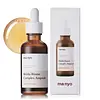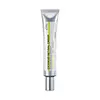What's inside
What's inside
 Key Ingredients
Key Ingredients

 Benefits
Benefits

 Concerns
Concerns

No concerns
 Ingredients Side-by-side
Ingredients Side-by-side

Bifida Ferment Lysate
Skin ConditioningButylene Glycol
HumectantBifida Ferment Filtrate
Skin ConditioningLactobacillus Ferment Lysate
Skin ConditioningLactococcus Ferment Lysate
Skin ConditioningSaccharomyces Ferment Filtrate
HumectantGlycerin
HumectantNiacinamide
Smoothing1,2-Hexanediol
Skin ConditioningLactobacillus/Pumpkin Fruit Ferment Filtrate
Skin ConditioningAureobasidium Pullulans Ferment
Skin ConditioningHyaluronic Acid
HumectantSodium Hyaluronate
HumectantSodium Hyaluronate Crosspolymer
HumectantSodium Acetylated Hyaluronate
HumectantHydrolyzed Sodium Hyaluronate
Skin ConditioningPotassium Hyaluronate
Skin ConditioningHydrolyzed Hyaluronic Acid
HumectantHydroxypropyltrimonium Hyaluronate
Leontopodium Alpinum Callus Culture Extract
AntioxidantCutibacterium Granulosum Ferment Extract Filtrate
EmollientAsiaticoside
AntioxidantAsiatic Acid
Skin ConditioningMadecassic Acid
Skin ConditioningPentylene Glycol
Skin ConditioningSqualane
EmollientHydrogenated Lecithin
EmulsifyingCopper Tripeptide-1
Skin ConditioningTromethamine
BufferingAcetyl Hexapeptide-8
HumectantPropanediol
SolventEthylhexylglycerin
Skin ConditioningDextrin
AbsorbentWater
Skin ConditioningCaffeine
Skin ConditioningBenzyl Glycol
SolventSodium Phytate
Hydrolyzed Algin
Xanthan Gum
EmulsifyingEpigallocatechin Gallate
AntioxidantCarbomer
Emulsion StabilisingPhysalis Alkekengi Calyx Extract
Skin ConditioningHydrolyzed Glycosaminoglycans
HumectantPolyglyceryl-10 Laurate
Skin ConditioningTheobroma Cacao Seed Extract
AntioxidantAdenosine
Skin ConditioningBifida Ferment Lysate, Butylene Glycol, Bifida Ferment Filtrate, Lactobacillus Ferment Lysate, Lactococcus Ferment Lysate, Saccharomyces Ferment Filtrate, Glycerin, Niacinamide, 1,2-Hexanediol, Lactobacillus/Pumpkin Fruit Ferment Filtrate, Aureobasidium Pullulans Ferment, Hyaluronic Acid, Sodium Hyaluronate, Sodium Hyaluronate Crosspolymer, Sodium Acetylated Hyaluronate, Hydrolyzed Sodium Hyaluronate, Potassium Hyaluronate, Hydrolyzed Hyaluronic Acid, Hydroxypropyltrimonium Hyaluronate, Leontopodium Alpinum Callus Culture Extract, Cutibacterium Granulosum Ferment Extract Filtrate, Asiaticoside, Asiatic Acid, Madecassic Acid, Pentylene Glycol, Squalane, Hydrogenated Lecithin, Copper Tripeptide-1, Tromethamine, Acetyl Hexapeptide-8, Propanediol, Ethylhexylglycerin, Dextrin, Water, Caffeine, Benzyl Glycol, Sodium Phytate, Hydrolyzed Algin, Xanthan Gum, Epigallocatechin Gallate, Carbomer, Physalis Alkekengi Calyx Extract, Hydrolyzed Glycosaminoglycans, Polyglyceryl-10 Laurate, Theobroma Cacao Seed Extract, Adenosine
Water
Skin ConditioningCaprylic/Capric Triglyceride
MaskingEthylhexyl Palmitate
EmollientGlycerin
HumectantButyrospermum Parkii Butter
Skin ConditioningDicaprylyl Carbonate
EmollientCaprylic/Capric/Myristic/Stearic Triglyceride
EmollientNiacinamide
SmoothingPentylene Glycol
Skin ConditioningHydrogenated Polydecene
EmollientPhenyl Trimethicone
Skin Conditioning1,2-Hexanediol
Skin ConditioningMacadamia Ternifolia Seed Oil
EmollientRetinal
Skin ConditioningMelia Azadirachta Flower Extract
Skin ConditioningMelia Azadirachta Leaf Extract
Skin ConditioningCurcuma Longa Root Extract
MaskingOcimum Sanctum Leaf Extract
Skin ConditioningCorallina Officinalis Extract
Skin ConditioningHydrolyzed Hyaluronic Acid
HumectantCentella Asiatica Extract
CleansingGlycine Soja Oil
EmollientPinus Pinaster Bark Extract
AntioxidantPolyglyceryl-6 Stearate
EmollientSynthetic Beeswax
Emulsion StabilisingCetearyl Olivate
Sorbitan Olivate
EmulsifyingSilica
AbrasiveButylene Glycol
HumectantPanthenol
Skin ConditioningSorbitan Stearate
EmulsifyingHydrogenated Lecithin
EmulsifyingHydroxyacetophenone
AntioxidantAmmonium Acryloyldimethyltaurate/Vp Copolymer
Pentaerythrityl Distearate
EmulsifyingSodium Acrylate/Sodium Acryloyldimethyl Taurate Copolymer
Emulsion StabilisingPalmitic Acid
EmollientPolyisobutene
Stearic Acid
CleansingPolyglyceryl-6 Behenate
Emulsion StabilisingCholesterol
EmollientBakuchiol
AntimicrobialBrassica Campestris Sterols
EmollientAdenosine
Skin ConditioningCeteth-3
EmulsifyingCeteth-5
EmulsifyingDipotassium Glycyrrhizate
HumectantTocopherol
AntioxidantAluminum/Magnesium Hydroxide Stearate
Emulsion StabilisingTocopheryl Acetate
AntioxidantSodium Phytate
Caprylyl/Capryl Glucoside
CleansingPotassium Cetyl Phosphate
EmulsifyingSorbitan Oleate
EmulsifyingPentaerythrityl Tetra-Di-T-Butyl Hydroxyhydrocinnamate
AntioxidantAllantoin
Skin ConditioningMadecassoside
AntioxidantCeramide NP
Skin ConditioningRetinol
Skin ConditioningStearyl Alcohol
EmollientCetyl Alcohol
EmollientMyristyl Alcohol
EmollientLauryl Alcohol
EmollientDisodium EDTA
PEG-5 Rapeseed Sterol
CleansingWater, Caprylic/Capric Triglyceride, Ethylhexyl Palmitate, Glycerin, Butyrospermum Parkii Butter, Dicaprylyl Carbonate, Caprylic/Capric/Myristic/Stearic Triglyceride, Niacinamide, Pentylene Glycol, Hydrogenated Polydecene, Phenyl Trimethicone, 1,2-Hexanediol, Macadamia Ternifolia Seed Oil, Retinal, Melia Azadirachta Flower Extract, Melia Azadirachta Leaf Extract, Curcuma Longa Root Extract, Ocimum Sanctum Leaf Extract, Corallina Officinalis Extract, Hydrolyzed Hyaluronic Acid, Centella Asiatica Extract, Glycine Soja Oil, Pinus Pinaster Bark Extract, Polyglyceryl-6 Stearate, Synthetic Beeswax, Cetearyl Olivate, Sorbitan Olivate, Silica, Butylene Glycol, Panthenol, Sorbitan Stearate, Hydrogenated Lecithin, Hydroxyacetophenone, Ammonium Acryloyldimethyltaurate/Vp Copolymer, Pentaerythrityl Distearate, Sodium Acrylate/Sodium Acryloyldimethyl Taurate Copolymer, Palmitic Acid, Polyisobutene, Stearic Acid, Polyglyceryl-6 Behenate, Cholesterol, Bakuchiol, Brassica Campestris Sterols, Adenosine, Ceteth-3, Ceteth-5, Dipotassium Glycyrrhizate, Tocopherol, Aluminum/Magnesium Hydroxide Stearate, Tocopheryl Acetate, Sodium Phytate, Caprylyl/Capryl Glucoside, Potassium Cetyl Phosphate, Sorbitan Oleate, Pentaerythrityl Tetra-Di-T-Butyl Hydroxyhydrocinnamate, Allantoin, Madecassoside, Ceramide NP, Retinol, Stearyl Alcohol, Cetyl Alcohol, Myristyl Alcohol, Lauryl Alcohol, Disodium EDTA, PEG-5 Rapeseed Sterol
 Reviews
Reviews

Ingredients Explained
These ingredients are found in both products.
Ingredients higher up in an ingredient list are typically present in a larger amount.
1,2-Hexanediol is a synthetic liquid and another multi-functional powerhouse.
It is a:
- Humectant, drawing moisture into the skin
- Emollient, helping to soften skin
- Solvent, dispersing and stabilizing formulas
- Preservative booster, enhancing the antimicrobial activity of other preservatives
Adenosine is in every living organism. It is one of four components in nucleic acids that helps store our DNA.
Adenosine has many benefits when used. These benefits include hydrating the skin, smoothing skin, and reducing wrinkles. Once applied, adenosine increases collagen production. It also helps with improving firmness and tissue repair.
Studies have found adenosine may also help with wound healing.
In skincare products, Adenosine is usually derived from yeast.
Learn more about AdenosineButylene Glycol (or BG) is used within cosmetic products for a few different reasons:
Overall, Butylene Glycol is a safe and well-rounded ingredient that works well with other ingredients.
Though this ingredient works well with most skin types, some people with sensitive skin may experience a reaction such as allergic rashes, closed comedones, or itchiness.
Learn more about Butylene GlycolGlycerin is already naturally found in your skin. It helps moisturize and protect your skin.
A study from 2016 found glycerin to be more effective as a humectant than AHAs and hyaluronic acid.
As a humectant, it helps the skin stay hydrated by pulling moisture to your skin. The low molecular weight of glycerin allows it to pull moisture into the deeper layers of your skin.
Hydrated skin improves your skin barrier; Your skin barrier helps protect against irritants and bacteria.
Glycerin has also been found to have antimicrobial and antiviral properties. Due to these properties, glycerin is often used in wound and burn treatments.
In cosmetics, glycerin is usually derived from plants such as soybean or palm. However, it can also be sourced from animals, such as tallow or animal fat.
This ingredient is organic, colorless, odorless, and non-toxic.
Glycerin is the name for this ingredient in American English. British English uses Glycerol/Glycerine.
Learn more about GlycerinHydrogenated Lecithin is created from the hydrogenation of lecithin (a group of phospholipids). Hydrogenation is a chemical reaction between hydrogen and another element.
This ingredient is an emollient and emulsifier. As an emollient, it helps soften skin by trapping moisture within. As an emulsifier, it prevents oil and water ingredients from separating.
Hydrolyzed Hyaluronic Acid is a form of hyaluronic acid. It is created by the hydrolysis of hyaluronic acid with a high molecular weight. Once created, Hydrolyzed Hyaluronic Acid has a low molecular weight.
Low molecular weight HA has been shown to hydrate and increase elasticity of the skin. Increasing elasticity is also associated with reduction of wrinkle depth.
One study found topical low molecular weight hyaluronic acid may be considered for the treatment of rosacea in the adult population. However, we always recommend speaking with a professional about your skin concerns.
Hyaluronic acids are a humectant. This means they draw moisture from the air. Hyaluronic acids help moisturize, soothe, and protect the skin.
Read more about other common forms of hyaluronic acid:
Learn more about Hydrolyzed Hyaluronic AcidNiacinamide is a multitasking form of vitamin B3 that strengthens the skin barrier, reduces pores and dark spots, regulates oil, and improves signs of aging.
And the best part? It's gentle and well-tolerated by most skin types, including sensitive and reactive skin.
You might have heard of "niacin flush", or the reddening of skin that causes itchiness. Niacinamide has not been found to cause this.
In very rare cases, some individuals may not be able to tolerate niacinamide at all or experience an allergic reaction to it.
If you are experiencing flaking, irritation, and dryness with this ingredient, be sure to double check all your products as this ingredient can be found in all categories of skincare.
When incorporating niacinamide into your routine, look out for concentration amounts. Typically, 5% niacinamide provides benefits such as fading dark spots. However, if you have sensitive skin, it is better to begin with a smaller concentration.
When you apply niacinamide to your skin, your body converts it into nicotinamide adenine dinucleotide (NAD). NAD is an essential coenzyme that is already found in your cells as "fuel" and powers countless biological processes.
In your skin, NAD helps repair cell damage, produce new healthy cells, support collagen production, strengthen the skin barrier, and fight environmental stressors (like UV and pollution).
Our natural NAD levels start to decline with age, leading to slower skin repair, visible aging, and a weaker skin barrier. By providing your skin niacinamide, you're recharging your skin's NAD levels. This leads to stronger, healthier, and younger looking skin.
Another name for vitamin B3 is nicotinamide. This vitamin is water-soluble and our bodies don't store it. We obtain Vitamin B3 from either food or skincare. Meat, fish, wheat, yeast, and leafy greens contain vitamin B3.
The type of niacinamide used in skincare is synthetically created.
Learn more about NiacinamidePentylene glycol is typically used within a product to thicken it. It also adds a smooth, soft, and moisturizing feel to the product. It is naturally found in plants such as sugar beets.
The hydrophilic trait of Pentylene Glycol makes it a humectant. As a humectant, Pentylene Glycol helps draw moisture from the air to your skin. This can help keep your skin hydrated.
This property also makes Pentylene Glycol a great texture enhancer. It can also help thicken or stabilize a product.
Pentylene Glycol also acts as a mild preservative and helps to keep a product microbe-free.
Some people may experience mild eye and skin irritation from Pentylene Glycol. We always recommend speaking with a professional about using this ingredient in your routine.
Pentylene Glycol has a low molecular weight and is part of the 1,2-glycol family.
Learn more about Pentylene GlycolSodium Phytate is the synthetic salt form of phytic acid. Phytic acid is an antioxidant and can be found in plant seeds.
Sodium Phytate is a chelating agent. Chelating agents help prevent metals from binding to water. This helps stabilize the ingredients and the product.
Water. It's the most common cosmetic ingredient of all. You'll usually see it at the top of ingredient lists, meaning that it makes up the largest part of the product.
So why is it so popular? Water most often acts as a solvent - this means that it helps dissolve other ingredients into the formulation.
You'll also recognize water as that liquid we all need to stay alive. If you see this, drink a glass of water. Stay hydrated!
Learn more about Water